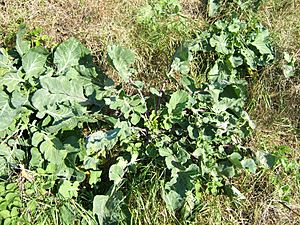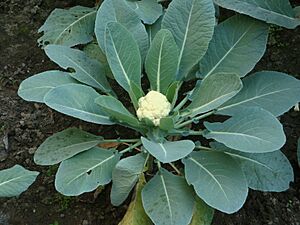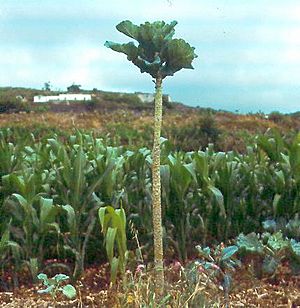Brassica oleracea facts for kids
Quick facts for kids Brassica oleracea |
|
|---|---|
 |
|
| Wild Cabbage plants | |
| Scientific classification | |
| Kingdom: | |
| (unranked): | |
| (unranked): | |
| (unranked): | |
| Order: | |
| Family: | |
| Genus: | |
| Species: |
B. oleracea
|
| Binomial name | |
| Brassica oleracea |
|
Brassica oleracea, also known as wild cabbage, is a type of plant. It grows naturally along the coasts of southern and western Europe. This plant is special because it's the ancestor of many common vegetables we eat today!
Wild cabbage can handle salt and lime in the soil. It doesn't like to compete with other plants. So, you often find it on limestone cliffs near the sea. This includes the chalk cliffs on both sides of the English Channel.
Contents
Wild Cabbage: A Super Plant!
People have been growing B. oleracea for thousands of years. Over time, farmers have carefully bred it into many different kinds of vegetables. These are called cultivars. Some of these vegetables look so different, it's hard to believe they come from the same wild cabbage!

This plant is useful because it stores a lot of food in its leaves. It keeps these food reserves over the winter. Wild cabbage is also full of important nutrients, like vitamin C.
Growing Many Kinds of Cabbage
The many types of B. oleracea are put into seven main groups. The Acephala Group looks the most like the original wild cabbage. Here are some of the groups and their famous members:
- Acephala Group: This includes kale and collard greens.
- Alboglabra Group: This group has Chinese broccoli.
- Botrytis Group: Here you'll find cauliflower, Romanesco broccoli, and broccoflower.
- Capitata Group: This is where regular cabbage belongs.
- Gemmifera Group: This group includes brussels sprouts.
- Gongylodes Group: This is the home of kohlrabi.
- Italica Group: This group contains broccoli.
All these vegetables are part of the same plant species. But, people have used something called artificial selection to create differences between them. This means farmers chose plants with certain traits and bred them. Over many years, this led to the different types we see today.
Tall "Tree Cabbages"
In places like the Channel Islands and Canary Islands, it rarely freezes. This allows some types of B. oleracea to grow all year. These plants can grow up to 3 meters (about 10 feet) tall! They are sometimes called "tree cabbages."

These tall plants provide fresh leaves all year long. Unlike regular cabbage, the whole plant isn't picked and destroyed. Their strong, woody stems are sometimes dried and used to make walking sticks!
Some B. oleracea vegetables, like brussels sprouts and broccoli, have high levels of a substance called sinigrin. Scientists are studying if this substance might help keep your bowel healthy.
Images for kids
See also
 In Spanish: Col silvestre para niños
In Spanish: Col silvestre para niños


